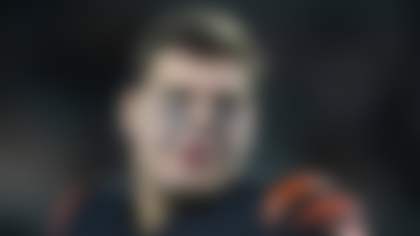INDIANAPOLIS -- Whether it's cooking, a first date, or a Super Bowl roster, the right mix is everything.
Last Friday I re-watched the 1990 NFC Championship Game between the Giants and the 49ers. The different makeup of the teams jumped off the screen -- one a defensive juggernaut, the other a two-time defending champion featuring an offense that changed the modern passing game. Both, however, had an incredible variety of talent, homegrown and acquired via trade, the USFL, or through the old "Plan B" free agency.
They also had a great mixture on the coaching staff. Bill Parcells' Giants in particular were loaded, with top-notch assistants in Bill Belichick and Tom Coughlin.
Back to the present, with Belichick's Patriots and Coughlin's Giants set to square off in Super Bowl XLVI, I wondered what those two assistants learned in New York, and how they applied it to building their clubs today.
How were these Super Bowl teams made? Are they in stark or mild contrast from each other, and other organizations across the league? On the surface, there's a lot of similarity in approach, roster, and method of winning. To wit:
» Each team is completely quarterback-driven, with both Tom Brady and Eli Manning falling into the NFL's best 10 players at the position.
» Neither organization believes in making high-priced splashes in free agency.
» Both use value-buy free agents as key role players, like the Patriots with Andre Carter this season.
Giants general manager Jerry Reese and New England's de facto GM Belichick fashioned these rosters in much the same way, valuing their own scouting departments. It's no mistake that this is Reese's second Super Bowl in five years on the job. For Belichick, it's his first as his own personnel chief, although the remnants of Scott Pioli's involvement still litter the roster.
Coughlin and Belichick, both Super Bowl-winning coaches, go with what they know, while being comfortable adapting to the changing state of the game. How they've adjusted to the fluctuating state of the NFL is the first fork in the road when it comes to the varying ways the Giants and Patriots were built.
Difference No. 1: Attacking middle of field
Belichick saw the writing on the wall in regards to recent rule changes that legislated aggressive secondary play out of the game and ushered in a new era of being able to throw inside the numbers safely. Thus, when an inconsistent Randy Moss and injured Wes Welker hampered his ability against the Ravens in the 2009 playoffs, Belichick drafted tight ends Rob Gronkowski and Aaron Hernandez to exploit the offensive shift.
The two big-play tight ends have caused mismatches for opposing defenses over the middle, as well as in the red zone. Without Gronkowski and Hernandez, New England wouldn't be playing for the Lombardi Trophy. Moreover, going two-tight is something Belichick picked up from working for Parcells, who liked the offensive alignment. Parcells did it with Mark Bavaro and Zeke Mowatt with the '80s Giants, and Jason Witten and Anthony Fasano with the Cowboys a few seasons ago.
Coughlin also was well-versed in Parcells' two-tight system, coaching wide receivers with the Giants from 1988 to 1990. With current offensive coordinator Kevin Gilbride's help, Coughlin often utilizes three in his offense with Jake Ballard, Travis Beckum, and Bear Pascoe.
Unlike New England, the Giants are built to attack the middle of the field differently. New York exposes league rules that don't allow safeties to punish receivers by attacking with various crossing routes from their wideouts. Hakeem Nicks, Mario Manningham, and Victor Cruz are explosive, and perhaps more importantly, all homegrown talent.
Cruz represents an area where both Big Blue and New England have thrived: undrafted free agents. The samba-dancing wideout is one of four starters on the Giants who were never drafted and never played for another club. Seven of the Patriots' 22 starters were undrafted. Coughlin and Belichick have been able to get something out of guys no one wanted at the big college party in April.
Where would the Pats be without receiving yardage leader Wes Welker or NFL interceptions leader Kyle Arrington, who both played with other teams but were ignored in the draft? How about running back BenJarvus Green-Ellis, who plays smart and hasn't lost a fumble in his pro career? None of these guys have a draft choice invested in their career, but have thrived in conditions that cater to their talent.
Difference No. 2: Defensive makeup
Breer: It's all about the DEs
The Giants' M.O. come draft day is simple – pick up defensive ends. That philosophy is a big reason why they're in Super Bowl XLVI, Albert Breer writes. **More ...**
That said, the kind of talent these clubs look for is divergent, particularly on the defensive side of the ball. The Giants have invested much more than the Pats in producing a stifling defense, as seven of New York's 11 starters were taken in the first three rounds. Three more starters were paid decent money in free agency: Chris Canty, cover linebacker Michael Boley, and safety Antrel Rolle. This talent is the biggest reason, with a nod to Eli Manning, that the Giants deep-sixed the Falcons, Packers, and Niners in succession.
The G-Men are a 4-3 team that rotates its linemen based on depth and the versatility of its front-line players. Justin Tuck has excelled on the interior and the end during his career. His ability to slide inside, despite being a natural end, gave former defensive coordinator Steve Spagnuolo the flexibility to use him alongside edge rushers Osi Umenyiora and Michael Strahan, a huge factor in the Giants beating the Patriots in Super Bowl XLII.
The Giants top five linemen this season -- Tuck, Umenyiora, Canty, Jason Pierre-Paul, and Linval Joseph -- were all taken in the first four rounds of the draft. Canty was a selection of the Cowboys, but his acquisition as a free agent is indicative of the emphasis this team puts on its defensive front.
The Patriots are the complete opposite.
Belichick's defense in Super Bowl XLII was a 3-4. All three down linemen were first-round draft picks -- Richard Seymour, Vince Wilfork and Ty Warren. Now, only Wilfork remains, and the Pats have switched mostly to a four-man front. None of the other current starting linemen were taken before the fifth round.
New England's defensive investments are littered in the back seven, with linebacker Jerod Mayo (first-rounder), Brandon Spikes (second), Devin McCourty (first), and Patrick Chung (second) all going early in the draft. This team is not built to wreak havoc up front; New England is a classic "bend but don't break" defensive unit. The back end of the defense's job is to not give up the easy score, and make teams earn their drives. (There's your reason for the Patriots finishing 31st in yards allowed but a much more palatable 15th in points allowed. Big difference.)
Difference No. 3: Offensive makeup
The Giants offense will try to get that defense to break more often than bend with Manning and his uber-productive receivers. Outside of Manning, Manningham and Nicks, guard Chris Snee is the only offensive starter Reese and Coughlin took in the first three rounds of the draft. The rest of the starters were late-round picks or free agents. Maybe we shouldn't be surprised the Giants have had trouble running the football this season.
Once again, New England offers a significant contrast. The Pats have four offensive linemen taken in either the first or second round. There's a reason Brady can sometimes sit back and pat, pat, pat the ball before making a throw.
Brady? He was an allegedly inferior prospect to his competition at Michigan -- the immortal Drew Henson -- and fell to the sixth round. We saw how that worked out: Henson missed curveballs in the minors while Brady threw fastballs (accurately) in the NFL.
And, on that note, we've seen how this season played out for Coughlin's Giants and Belichick's Patriots. These two clubs, led by men with similar roots but manufactured in contrasting ways, will be playing for the Lombardi Trophy. Super Bowl XLVI definitely has the potential to be a classic between two unique franchises, sort of of like that old 1990 NFC championship.
Follow Elliot Harrison on Twitter _@HarrisonNFL_




